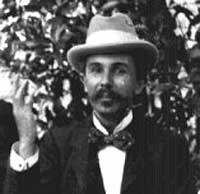 America's early film pioneer William K. L. Dickson (1860-1935) worked in the era of the kinetoscope, peep-show boxes. He worked most often with photographer William Heise.
America's early film pioneer William K. L. Dickson (1860-1935) worked in the era of the kinetoscope, peep-show boxes. He worked most often with photographer William Heise.
The earliest surviving sound film is his; Dickson's Experimental Sound Film (1894). Sound films would be a couple decades delayed because Dickson couldn't pursue this expensive research alone. He had a falling out with the Edison Manufacturing Co. in 1995 & eventually founded the rival American Mutoscope & Biograph Co, but the sound experiments ended.
He was friends with vaudevillians whom he convinced to become part of the novel new entertainment. In the main his films captured moments, small events, & condensed vaudeville acts, but did not tell stories. This in great part accounts for his low standing as a filmmaker per se, though his company would be issuing major films with major stars like Lionel Barrymore & directors like D. W. Griffith.
There was however a hint of Dickson's greater storytelling potential in Rip Van Winkle (1896), which has the kind of structure & content missing from his other films. Business requirements of running the European branch of Biograph caused him to give no more time to hands-on filmmaking in the new century.
His minor films aren't merely historic relics, but can have great charm, as can any album of vintage photographs, with the bonus of motion.
As an inventor he's at the higher end of significance. Though Edison had a habit of taking credit for everything his hirelings did, it really was Dickson who made the phonograph practical, & he had every intent to get it to synchronize with film footage. He was the key inventor for motion picture recording devices, devised the film emulsions that made rapid film photography possible, & even established the standard film size at 35 mm which would never change.
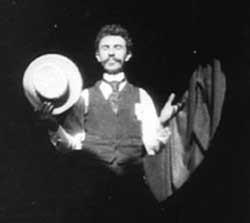 Modernly titled Dickson Greeting (1891) this three-second test footage shows a young William Dickson making an elaborate greeting with his hat.
Modernly titled Dickson Greeting (1891) this three-second test footage shows a young William Dickson making an elaborate greeting with his hat.
It is among the first of all films, & today often shown in a loop several times in a row to give the viewer time to actually see what is happening in this moment in time, a moment that only becomes amazing when you realize Dickson's polite tip of the hat is like an invitation to an entire world of cinema which would soon explode into existence.
Though there's nothing much to it beyond an incredible historical significance, it was nevertheless exhibited at the National Federation of Women's Clubs, making it one of the first-ever exhibited films.
Another early fragment, now known as Newark Athlete (1891) is just a three-second clip of a young man who isn't even that athletic looking. It's a precursor to many Physical Culture films Dickson would be making, as much for their beefcake value as for health & athleticism. The Newark Athlete however is more like a spirit-film revealing the nascent soul of cinema.
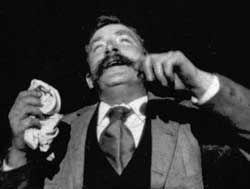 Fred Ott's Sneeze; aka, Edison Kinetoscopic Record of a Sneeze (1894) implies what fun everyone was having developing a whole new industry.
Fred Ott's Sneeze; aka, Edison Kinetoscopic Record of a Sneeze (1894) implies what fun everyone was having developing a whole new industry.
Who hasn't tried to "sneeze with your eyes open" or held their breath while waiting for someone else's sneeze to finally come forth?
The human fascination for bodily functions made the idea of capturing a sneeze on film as natural as little kids laughing at references to farts or boogers.
So one of Thomas Edison's assistants was called upon to "star" in a five-second film which captures a sneeze. It became the sneeze that was seen, but not heard, round the world.
Fred takes a pinch of snuff & sneezes; there's no more to it than that. Yet this was the first film ever copyrighted in America, & was used as a mild amusement to get lots of publicity for the Edison company's film projects.
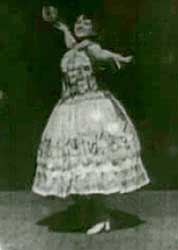 Dickson can lay claim to just one "first" after another. Carmencita (1894) was directed by Dickson & filmed by William Heise features.
Dickson can lay claim to just one "first" after another. Carmencita (1894) was directed by Dickson & filmed by William Heise features.
The dancer had already been performing at Koster & Bial's New York theater for four years, & would now be seen worldwide in a third of a minute of film.
She is thought to have been the first woman ever to perform in front of a motion picture camera; she's certainly the first to do so at America's first film studio, Black Maria.
Her Spanish dance in long flowing skirt shows a good deal of natural rather than dance-trained talent. Such dance films would become common productions at Black Maria.
Like the internet of a modern age, the peepshow boxes that showed films for a penny each were not made commercially viable by improving peoples' access to the arts. As with the internet a century later, the first profitable uses were sports scores, & porn. And inside a kinetoscope, two of the most popular themes were boxing, & mild erotica, the latter often disguised as cultural though the performers were derived from vaudeville rather than legitimate arts.
Given the mild sexploitative ingredient to similar films that followed, for what began as a primarily male audience plunking down pennies to look inside peepshow boxes, one would expect the Carmencita's flowing skirts to rise high enough to see a lot of leg. In dance films to follow, a body sock would often go clear to the crotch so that "all" could be revealed. In this pilot effort, however, good taste prevails.
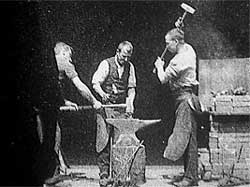 Dickson's Blacksmith Scene (1893) is another "first," the first known incident of actors playing roles in front of a motion picture camera, as opposed to earlier films in which people pretty much played themselves.
Dickson's Blacksmith Scene (1893) is another "first," the first known incident of actors playing roles in front of a motion picture camera, as opposed to earlier films in which people pretty much played themselves.
The blacksmiths are played by employees of Edison. They pound rhythmically & manage in a half-minute of labor to find time to take a break for a beer.
A similar set-up was concocted for The Barber Shop (1894). A sign over the barber chair reads, "The Latest Wonder: Shave & a Haircut for a Nickel." In under a minute, with a cast of four, we witness both the practical & the social value of the barbershop.
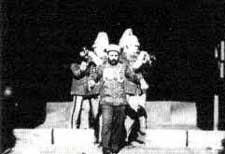 Band Drill is a two & a half-minute scene imitated from Charles A. Hoyt's musical burlesque A Milk White Flag, a spoof of militarism.
Band Drill is a two & a half-minute scene imitated from Charles A. Hoyt's musical burlesque A Milk White Flag, a spoof of militarism.
None of the "message" of the play is conveyed by this recreated moment, but the play presumedly was well enough known that knowledge of the intent would be brought to the view-port by kinetoscope customers.
The burlesque play expressed the patriotic feeling that only the bearer of the milk white flag was brave enough to stand in battle, this being the flag of purity, which the audience well knew was actually the flag of surrender.
The film however just shows the band playing what would appear to be a march, conducted by a short bandmaster (Frank Baldwin). Part of the art of these tiny films was to convey "sound" where there was none.
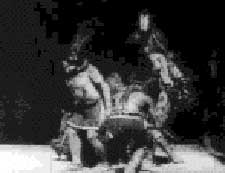 Buffalo Dance (1894) is a sixteen second recording of Sioux Indians in loincloths & feathers, doing a squat-dance round & round in circles & looking so intensely at the camera that it's unintentionally funny.
Buffalo Dance (1894) is a sixteen second recording of Sioux Indians in loincloths & feathers, doing a squat-dance round & round in circles & looking so intensely at the camera that it's unintentionally funny.
Three Sioux are dancing; two others play drums. The dancers were in New York with the Buffalo Bill Wild West Show, & their names are known: Hair Coat, Parts His Hair, & Last Horse.
A companion piece at about 24 seconds is Sioux Ghost Dance (1894), with quite a few more Sioux gathered in front of the camera, including a kid. Someone must've mentioned not to keep looking at the camera after Buffalo Dance as this time they're really excitedly into the dance rather than the film recording device.
These two Native American dance films were made while the wild west show was at Ambrose Park. They were made for the European distributors Maguire & Baucus, Bill Cody having wanted the advance advertising these snippets would get him, just before he took his show to Europe.
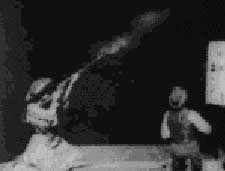 Many a cowboy has been alleged as the first film star, but most would have to invent several hithertos & howfors to place themselves ahead of Lee Martin & his famed horse Sunfish.
Many a cowboy has been alleged as the first film star, but most would have to invent several hithertos & howfors to place themselves ahead of Lee Martin & his famed horse Sunfish.
Martin appears in Bucking Broncho (1894) in what looks like an ordinary rodeo moment, & interesting to realize that Sunfish is bucking on cue as part of an act.
Standing upright balanced on the corral fence is sharpshooter Frank Hammitt who fires into the corral for extra effect. Hammit & Martin were both part of the Buffalo Bill Wild West Show when it toured the US, but not Europe. The scene ends with a row of spectators clapping in the background.
Obviously it wouldn't do to skip past Annie Oakley (1894) while making kinetographic records of Buffalo Bill's Wild West Show's stars. If this little film had been our best surviving image of Annie, then she wouldn't be iconic, but even so it's nice to see her natural show-woman's posture in motion.
Her act was constrained by the Black Maria studio stage, but she's mildly impressive with her rifle shooting targets off a nearby board, & vastly more impressive shooting glass balls thrown in the air one by one.
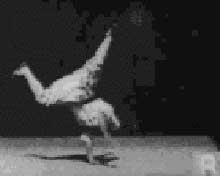 Hadj Cheriff (1894) was an extremely antic vaudeville "tumbler" shown here hopping & flipping like a maniac for less than a minute. This performance has been called a precursor to break-dancing.
Hadj Cheriff (1894) was an extremely antic vaudeville "tumbler" shown here hopping & flipping like a maniac for less than a minute. This performance has been called a precursor to break-dancing.
Though the film is also known as Hadj Cheriff Arab Knife Juggler, there is no juggling in this film, though he was famous for doing much more than the tumbling act.
He was a regular at the Midway Plaisance, where he headed a small troupe that got in trouble with the police due to his wife's sexy dance performances. He eventually joining Buffalo Bill's Wild West Show, even though he purported to be a dervish rather than a wild west Indian.
The Hadj performed feats of strength, juggling, & all sorts of stunts with surprising grace. For a while he had his own travelling troupe of acrobats who posed as whirling dirvishes. The wild antics of men & women on stage together got the act raided by the police for alleged indecency.
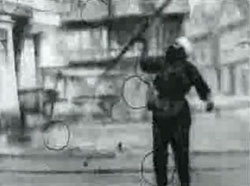 He later joined up with Buffalo Bill Cody's Wild West Show & made his connection to the Black Maria studio along with Annie Oakley & others of Cody's troupe. He later joined up with Buffalo Bill Cody's Wild West Show & made his connection to the Black Maria studio along with Annie Oakley & others of Cody's troupe.
His 1894 film appearance isn't quite all we'll ever be able to see of his act, as this exciting performer is also the star of Arabian Gun Twirler (1899).
This latter is another minute of high action, but filmed after Dickson was long gone from the Black Maria studio. It was filmed by James H. White.
On stage in front of a painted backdrop depicting a village square, wearing a Turkish or Arabic infantry costume, Hadj Cheriff performs baton twirling with a large rifle instead of a baton, pirouetting & periodically stabbing or aiming with the rifle. The poorly preserved film ends suddenly with no big finale for the act.
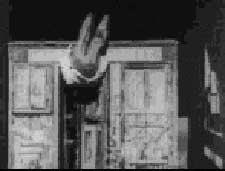 Less than a minute of silly antics can be observed in Chinese Laundry (1895) which depicts an Irish policeman & a fake Chinese guy (named "Hop Lee" in contemporary catalogs) going in & out of two doors in ridiculous chase sequence.
Less than a minute of silly antics can be observed in Chinese Laundry (1895) which depicts an Irish policeman & a fake Chinese guy (named "Hop Lee" in contemporary catalogs) going in & out of two doors in ridiculous chase sequence.
This doesn't seem to have much of a point even for days when "the pictures are moving, that's enough!" The vaudevillians who are playing the racially stereotyped stock characters are the comedy team of Robetta & Doretto.
We may rightly assume this is typical of the ordinary vaudeville talent, as opposed to good vaudeville talent, & that's something worth learning. Robetta & Doretto starred in two other of Dickson's short-shorts which I've not seen. Chinese Laundry was second in the series, commonly catalogued separately as Robetta & Doretto 1, 2, 3, of which only the second survives.
copyright © by Paghat the Ratgirl
|
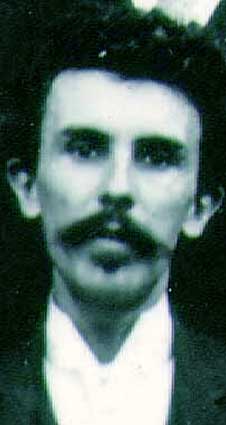









 He later joined up with Buffalo Bill Cody's Wild West Show & made his connection to the Black Maria studio along with Annie Oakley & others of Cody's troupe.
He later joined up with Buffalo Bill Cody's Wild West Show & made his connection to the Black Maria studio along with Annie Oakley & others of Cody's troupe.